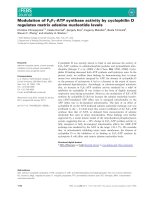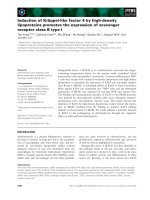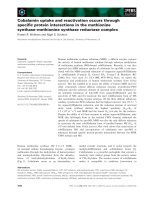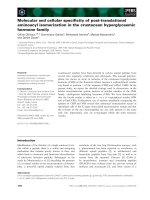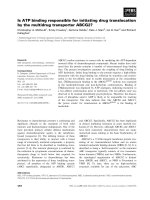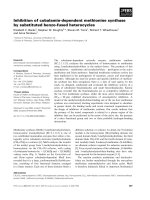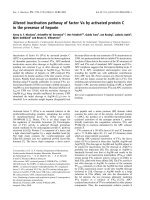báo cáo khoa học: " Is untargeted educational outreach visiting delivered by pharmaceutical advisers effective in primary care? A pragmatic randomized controlled trial" pptx
Bạn đang xem bản rút gọn của tài liệu. Xem và tải ngay bản đầy đủ của tài liệu tại đây (254.94 KB, 8 trang )
BioMed Central
Page 1 of 8
(page number not for citation purposes)
Implementation Science
Open Access
Research article
Is untargeted educational outreach visiting delivered by
pharmaceutical advisers effective in primary care? A pragmatic
randomized controlled trial
Martin P Eccles, Ian N Steen, Paula M Whitty* and Lesley Hall
Address: Institute of Health and Society, Newcastle University, 21 Claremont Place, Newcastle upon Tyne NE2 4AA, UK
Email: Martin P Eccles - ; Ian N Steen - ; Paula M Whitty* - ;
Lesley Hall -
* Corresponding author
Abstract
Background: There is increasing evidence that clinical guidelines can lead to improvements in
clinical care. However, they are not self-implementing. While educational outreach visits may
improve prescribing behaviour, the effectiveness of routine delivery of these visits by existing
pharmaceutical advisers is unknown.
Methods: Within a pragmatic randomized controlled trial, involving all general practices in two
primary care trusts (PCTs), routine methods were used to distribute guidelines for the choice of
antidepressants for the management of depression. Intervention practices were offered two visits
(most accepted only one) by their PCT pharmaceutical adviser who had been trained in the
techniques of outreach visiting. Intervention practices were visited regardless of whether they had
prior problems with prescribing ('untargeted' visits). The intervention was evaluated using level
three prescribing analysis and cost (PACT) data for antidepressant drugs for the six months during
which the intervention was delivered and the subsequent twelve months.
Results: Across the 72 study practices there was no significant impact of the intervention on usage
of any group of antidepressant drugs.
Conclusion: The routine use of untargeted educational outreach visiting delivered by existing
pharmaceutical advisers may not be a worthwhile strategy.
Trial registration: ClinicalTrials.gov NCT00393536
Background
There is increasing evidence that clinical guidelines can
lead to improvements in both the process and outcome of
care [1]. They figure prominently within the UK, particu-
larly since the inception of the Scottish Intercollegiate
Guidelines Network (SIGN) and the National Institute for
Health and Clinical Excellence (NICE). However, clinical
guidelines are not self-implementing, and there is a grow-
ing body of research that demonstrates the effectiveness of
various implementation strategies [1]. This has suggested
that while the commonly used strategy of the postal distri-
bution of educational materials alone may change clini-
cians' behaviour, it is unlikely to lead to large changes in
practice. Educational outreach visits, using a trained per-
Published: 26 July 2007
Implementation Science 2007, 2:23 doi:10.1186/1748-5908-2-23
Received: 17 August 2006
Accepted: 26 July 2007
This article is available from: />© 2007 Eccles et al; licensee BioMed Central Ltd.
This is an Open Access article distributed under the terms of the Creative Commons Attribution License ( />),
which permits unrestricted use, distribution, and reproduction in any medium, provided the original work is properly cited.
Implementation Science 2007, 2:23 />Page 2 of 8
(page number not for citation purposes)
son to meet face-to-face with a health care professional to
provide information, may improve practice, especially
prescribing behaviour [1,2].
Estimating the effectiveness of educational outreach is
complicated by the fact that it is often evaluated as one
part of a multi-faceted package, incorporating additional
elements such as educational materials, educational meet-
ings, or audit and feedback; Grimshaw et al. found this to
be the case in all of the 35 studies that they identified in
their systematic review [1]. O'Brien et al concluded that
"educational outreach visits, particularly when combined
with social marketing, appear to be a promising approach
to modifying health professional behaviour, especially
prescribing" [2]. Grimshaw et al. found a mixed pattern of
results. When considering dichotomous measures of the
process of care, they found that educational outreach
combined with one other intervention produced a
median absolute difference of +2% to +13%. In combina-
tion with two other interventions the result for the single
study was +11%, and in combination with three other
interventions the range of effects was -2% to +6%. The
pattern for continuous measures of the process of care was
similar, while the effects were consistently smaller for
dichotomous measures of outcome of care. There have
been 12 trials published since the more recent of these
reviews, and their results are consistent with this mixed
pattern of effect across settings and targeted conditions [3-
14]. However, of the five that focused mainly or exclu-
sively on prescribing, four were negative [6,12-14] and the
fifth showed positive effects only in small general prac-
tices [11].
Of the five previous studies of the effectiveness of educa-
tional outreach visiting in influencing prescribing in the
UK NHS [11,12,14-16], three have used pharmacists as
the visitors [11,12,14]. This is of particular interest as all
primary care trusts (PCTs) in England employ pharmaceu-
tical advisers. They are usually pharmacists whose role is
to provide, from a wide clinical and health service man-
agement perspective, advice on prescribing and related
areas to general practitioners (GPs). Pharmaceutical advis-
ers routinely visit general practices and are seen as change
agents; however, the formal delivery of educational out-
reach by them has not been evaluated.
In 1996, the then Newcastle and North Tyneside Health
Authority established a clinical effectiveness unit. The
remit of the unit was to provide support to local health
care teams in primary and secondary care, with the aim of
promoting clinical effectiveness and encouraging the use
of best evidence in daily practice through systematic, evi-
dence-based approaches to guideline implementation.
The strategy adopted by the clinical effectiveness unit was
to concentrate on five clinical areas. These were selected
by a multi-disciplinary steering group using explicit crite-
ria (evidence of inappropriate variation in practice; a good
evidence base for what should be done; the clinical area
should be a source of significant morbidity or mortality;
large cost implications in the management of the topic).
Depression was one of the clinical areas chosen: depres-
sion is an area of significant morbidity (depression affects
between 5% and 10% of individuals in the UK and is the
third most common reason for consultation in general
practice [17]); the costs of antidepressant prescribing had
been rising steadily through the 1990s [18].
The aim of this study was to evaluate the effectiveness of
outreach visiting by existing pharmaceutical advisers, in
addition to the postal distribution of educational materi-
als, for the choice of antidepressants in the management
of depression.
Methods
Study design
The study was a pragmatic cluster randomized controlled
trial based in two PCTs with general practices as the unit
of randomization and analysis [19]. Randomization,
stratified by PCT, was performed by numbering the prac-
tices then allocating them to either intervention or control
groups according to a computer-generated random
number list. Because the study was restricted to a defined
geographical area, the total number of available general
practices (73) was pre-determined. (See power calculation
for more detail.)
The guidelines
The aim of the guidelines was to advise GPs on the most
cost-effective choice of antidepressants to manage depres-
sion in primary care [20]. The guidelines were developed
using standard methods by a multi-disciplinary group of
GPs, secondary care mental health specialists and phar-
maceutical advisers [21]. The key recommendations from
the guidelines can be summarised as:
• 'Consider tricyclics first – as they represent a less expen-
sive option, tricyclic antidepressants (TCAs) should be
used as the routine first line drug treatment for depression
in primary care.'
• The choice of antidepressant should be based on indi-
vidual patient factors (expanded in the guidelines).
• If the toxic effects of the older TCAs are perceived to be
a problem, eg in a patient who has previously taken a drug
overdose, then lofepramine is a more cost effective choice
than an SSRI.
• The dose of TCAs should be titrated up to the doses sug-
gested (examples given).
Implementation Science 2007, 2:23 />Page 3 of 8
(page number not for citation purposes)
• When faced with a patient not responding to first line
drug therapy, reasonable options are (five options given).
The guidelines were distributed through the PCT courier
or postal system to each individual GP in Newcastle and
North Tyneside during the three month period of April to
June 1999. This was the only specific intervention that
control group practices received.
Educational outreach visiting
The six pharmaceutical advisers employed by Newcastle
PCT and North Tyneside PCT agreed to deliver the out-
reach visits within the context of the trial. Shortly after the
guidelines were distributed, they wrote to all intervention
practices with the offer of a visit. This was followed up by
a telephone call. The visits took place between July and
December 1999. The purpose of the visit was to encourage
implementation of the main messages from the guide-
lines using the principles of outreach visiting [22], in
which they received training specifically for the study.
Within the visit, they explored GPs' knowledge and pat-
terns of current activity, offered clear behavioural objec-
tives (identifying, investigating, and treating patients),
and acknowledged areas of controversy (such as differing
treatment regimes and their cost). They used a pre-devel-
oped set of educational materials based on the content of
the guidelines. These materials concisely represented the
issues, although key messages were highlighted and
repeated at the end of the session. Two visits were
planned, four to six weeks apart. When performing the
visits the advisers attempted to see, in each visit, as many
of the GPs in a practice as possible.
Analysis
The analysis was based on routinely available prescribing
data (level three prescribing analysis and cost (PACT)
data). As the unit of analysis was the practice, this was
aggregated to the practice level. Prescribing data for the
main categories of antidepressants (see below) from the
eighteen months from July 1999 to December 2000 (from
the first visits in July 1999 up to and including December
2000, four quarters after the final visits in December
1999) were used for the analysis. Data for the 12 months
prior to the intervention were not available. Data for the
period during which the intervention was being delivered
(July to December 1999) were available, and were
included in the model for the primary analysis (see
below). PACT data provide total quantity of dose units
(tablets or capsules) prescribed, and total costs per prac-
tice in each quarter. ASTRO PUs (age, sex and temporary
resident originated prescribing units) are designed to
weight individual practice populations for age, sex and
temporary residents [23]. Two practices may have the
same number of patients, but if one has a predominantly
older population it will have a higher ASTRO PU value. A
practice that had many students registered may have a
large list size, but a relatively low ASTRO PU value.
ASTROPU values are accepted as a more accurate measure
of prescribing need than list size alone, although ASTRO-
PUs are not related to deprivation levels. We used the total
number of dose units per practice, per quarter, adjusted
for practice size to achieve mean prescribing dose unit per
ASTRO PU. We also analysed cost per ASTRO PU. We con-
sidered all the main categories of antidepressants as
potential indicators, including tricyclic antidepressants
(TCAs), selective serotonin reuptake inhibitors (SSRIs),
and monoamine oxidase inhibitors (MAOIs). Addition-
ally, we examined lofepramine individually, as this drug
was specifically identified within the guidelines as an
alternative to TCAs where there were concerns about sui-
cide risk. While it would have been desirable to exclude
the use of antidepressants for conditions other than
depression (e.g., by excluding low doses and/or short
courses), this was not possible using PACT data, which
provide information only on total quantity and strength.
The analysis, comparing prescribing of antidepressant
drugs within those practices offered a visit compared with
control practices during the 12 month period following
the introduction of the guidelines, was an analysis of cov-
ariance, in which the dependent variables were items per
ASTRO PU and cost per ASTRO PU.
Drug use was analysed by practice and by quarter. For
each practice, we had a series of repeated measures: quar-
terly data for the six months of the intervention period
and the twelve month period following the intervention.
Drug use was analysed using multilevel modeling to
account for the repeated measures (quarters nested within
practices). Variation between practices and variation
between quarters within practices were modeled as ran-
dom effects. In a preliminary analysis, we modeled the
trend in drug use across all six quarters. In the main anal-
ysis, we modeled the four quarters corresponding to the
post-intervention period and included the two quarters
data for the intervention period (July through December
1999) as covariates. An indicator variable was defined to
take a value of one for observations corresponding to
practices randomized to receive the intervention in quar-
ters following the intervention and zero for all other
observations. The effect of the intervention was thus mod-
eled as a fixed effect. Interval estimates of effect size are
given.
Power calculation
As reported earlier, the total number of available general
practices (73) was pre-determined. With 36 practices ran-
domized to intervention and 37 to control, we deter-
mined that we had 80% power to detect an effect size of
0.66 standard deviations in our outcome measures,
Implementation Science 2007, 2:23 />Page 4 of 8
(page number not for citation purposes)
assuming a type one error rate of 0.05. This equates
approximately to a mean difference per ASTRO PU of 0.5
items of lofepramine, 2.4 items of other TCAs, 1.5 items
of SSRIs, and 0.05 items of MAOIs.
Confidentiality issues
The use of aggregated practice level data meant that it was
possible to maintain anonymity of individual GPs. The
PCTs supplied the prescribing data and, to enable us to
identify the intervention and control practices for analy-
sis, codes were developed and used by the PCTs to mark
data accordingly. A letter was sent to every GP in the dis-
trict outlining the study, informing them that anony-
mous, aggregated PACT data were being used for analysis,
and assuring them of confidentiality. A representative
from the clinical effectiveness unit and the PCTs each
signed this letter. Because patients were not directly
involved, and no patient identifiable data were to be
included in the final analysis, a formal application to the
local ethics committee was, on enquiry, deemed unneces-
sary.
Results
All 73 practices in Newcastle and North Tyneside were
invited into the study. Of the 73 practices originally ran-
domised (36 intervention and 37 control), one interven-
tion practice opted out prior to receiving a visit, leaving 35
intervention and 37 control practices. The breakdown of
number of GP partners per practice for intervention and
control groups is provided in Table 1.
All intervention practices were visited once. Most practices
declined a second visit four to six weeks later, saying that
this was too soon after the first visit. Six intervention prac-
tices received a second visit within six months of the first
one. Pharmaceutical advisers returned records of their vis-
its for 20 of the intervention practices. Visits lasted
between 20 and 45 minutes. For ten visits (50%), all part-
ners were present; six visits (33.3%), only one partner was
missing, and, for the remainder, two and three partners
were missing in one visit each respectively, and four part-
ners were missing for two visits. In some cases, practice
managers, community pharmacists and practice nurses
also attended.
The level of prescribing of, and costs per ASTRO PU for,
TCAs, lofepramine, SSRIs and MAOIs, analysed by quarter
and by treatment allocation are shown in Table 2.
The results of the main analysis are shown in Table 3. Dur-
ing the period July 1999 to December 2000, across all
practices usage of SSRIs rose significantly overall (in inter-
vention and control groups combined; average change per
quarter across the six quarters across all 72 practices 0.27;
95% confidence interval (CI) 0.24, 0.30). In contrast,
there was a very slight downward trend in MAOIs (average
change per quarter -0.004, 95% CI -0.006, -0.002) (Table
3). Also over this period, costs of lofepramine (-0.23, 95%
CI -0.34, -0.12), TCAs (-0.28, 95% CI -0.44, -0.12), and
MAOIs (-0.08, 95% CI -0.11, -0.04) were reduced.
The analysis of antidepressant prescribing showed no sig-
nificant impact of the intervention on usage of TCAs, lofe-
pramine, SSRIs, or MAOIs. Change in prescribing as items
per AstroPU for TCAs was +0.02 (95% CI -0.42, 0.46); for
lofepramine was +0.02 (95% CI -0.11, 0.16); for SSRIs
was -0.03 (95% CI -0.34, 0.27); and for MAOIs was 0.00
(95% CI -0.02, 0.02)(Table 3).
While the costs of TCAs in intervention practices stayed
about the same over the period, there was a slight decrease
in costs of TCAs in control practices; this difference was
significant at the 5% level. The cost of TCAs per AstroPU
in intervention practices was estimated to be £1.18
(95%CI £0.03, £2.32) higher than in control practices.
Discussion
This study showed no effect on the volume of drugs pre-
scribed within a pragmatic evaluation of educational out-
reach visiting by pharmacy advisers in a service setting.
Table 1: Practice characteristics: number of GP partners in intervention and control practices
Number of practices
Number of GP partners per practice Intervention group Control group
155
256
3105
4410
543
636
731
811
Total number of practices 35 37
Implementation Science 2007, 2:23 />Page 5 of 8
(page number not for citation purposes)
The study is therefore a negative trial, which is at variance
with the results of most of the previously reported studies
[2]. There are a number of possible explanations for this.
Given that the study was based in a pre-defined geograph-
ical area and the number of general practices was therefore
fixed, it is possible that the study was underpowered and
our negative result was a type two error. This possibility
can be considered by examining the different groups of
antidepressants separately. For lofepramine, prescribing
levels throughout the period of the study were approxi-
mately one item per ASTROPU for control practices, and
slightly less for intervention practices (Table 2). The esti-
mated effect of the intervention was a change in the pre-
scribing of lofepramine of between -0.11 to +0.15 units
(Table 3). The maximum possible change would therefore
have been on the order of 10 to 15%. If 15% would have
been a clinically important change, then power is a possi-
ble explanation for not detecting a significant effect. How-
ever, for the period of the study prescribing levels for TCAs
were running at around seven to eight items per ASTRO
PU across all practices (Table 2). The estimated effect of
the intervention was a change of between -0.42 and +0.46
units (Table 3). These 95% confidence limits correspond
to changes of 5 to 6% in drug prescribing, so the possibil-
ity of a clinically important difference can probably be
discounted. Power is therefore unlikely to be an explana-
tion for failing to detect a difference in TCAs.
The outreach visits were delivered in addition to all GPs
having received a paper copy of the guidelines, and at the
time this study was designed this was felt to be both good
practice in disseminating information and an ineffective
way of changing behaviour. However, a subsequent
review of guideline implementation strategies concluded
that there was the possibility of modest effects from the
postal distribution of educational materials [1]. There-
fore, it is possible that our background intervention could
Table 2: Mean prescribing dose units of TCAs, lofepramine, SSRIs and MAOIs per AstroPU, and costs per AstroPU, per quarter
Mean number of items prescribed per ASTROPU by quarter by group
Quarter 99/00 (2
nd
) 99/00 (3
rd
) 99/00 (4
th
) 00/01 (1
st
) 00/01 (2
nd
) 00/01 (3
rd
)
Drug Group meansdmeansdmeansdmeansdmeansdmeansd
lofepramine Intervention 0.93 0.86 0.96 0.75 0.93 0.87 0.89 0.77 0.94 0.80 0.93 0.91
Control 1.08 0.74 1.06 0.68 1.02 0.74 1.05 0.67 0.99 0.65 0.98 0.68
All 1.01 0.80. 1.01 0.71 0.98 0.80 0.97 0.72 0.96 0.72 0.95 0.74
Other TCAs Intervention 7.33 4.14 7.53 4.16 7.32 4.39 7.16 4.03 7.31 4.23 7.52 4.27
Control 7.70 3.21 7.80 3.12 7.39 2.89 7.58 2.69 7.54 2.58 7.79 2.60
All 7.52 3.67 7.67 3.64 7.35 3.67 7.38 3.39 7.43 3.46 7.66 3.49
SSRIs Intervention 6.04 2.32 6.32 2.39 6.44 2.42 6.77 2.41 6.97 2.65 7.36 2.67
Control 6.36 1.75 6.65 2.03 6.74 2.03 7.01 2.17 7.38 2.15 7.86 2.17
All 6.21 2.04 6.49 2.20 6.59 2.22 6.89 2.28 7.18 2.40 7.62 2.42
MAOIs Intervention 0.04 0.07 0.05 0.10 0.04 0.06 0.05 0.07 0.05 0.07 0.04 0.07
Control 0.06 0.08 0.06 0.08 0.05 0.06 0.05 0.06 0.04 0.05 0.04 0.05
All 0.05 0.08 0.06 0.09 0.04 0.06 0.05 0.07 0.04 0.06 0.04 0.06
Mean cost items prescribed per ASTROPU by quarter by group
Quarter 99/00 (2
nd
) 99/00 (3
rd
) 99/00 (4
th
) 00/01 (1
st
) 00/01 (2
nd
) 00/01 (3
rd
)
Drug Group meansdmeansdmeansdmeansdmeansdmeanSd
lofepramine Intervention 8.83 6.74 9.21 6.33 9.00 6.98 8.35 6.32 8.45 6.67 8.21 6.48
Control 9.72 6.88 9.64 6.26 9.00 6.86 9.04 6.15 8.65 5.76 8.33 5.87
All 9.29 6.78 9.43 6.25 9.00 6.87 8.70 6.20 8.56 6.18 8.27 6.13
Other TCAs Intervention 25.62 15.45 28.76 16.87 28.17 16.37 27.27 15.48 26.47 14.84 26.13 14.40
Control 24.85 7.09 27.84 8.54 26.08 8.18 25.68 7.63 24.20 6.77 24.28 6.88
All 25.22 11.83 28.29 13.18 27.09 12.78 26.45 12.04 25.30 11.40 25.18 11.14
SSRIs Intervention 132.60 49.52 132.93 49.09 131.59 45.76 117.65 39.66 109.00 41.21 112.06 42.45
Control 141.25 55.29 142.62 55.80 140.78 54.79 122.39 38.04 114.91 33.15 116.52 38.69
All 137.04 52.38 137.91 52.50 136.31 50.46 120.09 38.63 112.04 37.14 114.35 40.34
MAOIs Intervention 0.57 0.97 0.71 1.24 0.55 0.94 0.55 0.88 0.55 0.79 0.51 0.76
Control 0.95 1.17 0.99 1.39 0.78 1.04 0.80 1.11 0.71 0.99 0.68 0.88
All 0.77 1.09 0.85 1.32 0.67 0.99 0.68 1.01 0.63 0.90 0.60 0.82
Implementation Science 2007, 2:23 />Page 6 of 8
(page number not for citation purposes)
have had a small effect that decreased our power to find
an effect from outreach visiting. It is also possible that
there was "leaking" of the intervention into control prac-
tices by the informal contact of doctors in intervention
and control practices. We feel this is unlikely to be a prob-
lem for two reasons. Grimshaw et al. [1] showed that
informal contact between general practices around two
clinical areas was low, and any impact of an educational
outreach visit would be considerably diluted if it was
reported secondhand. Contamination of control practices
by contact with the pharmaceutical advisers, who did not
use any of the formal materials or methods in control
practices, was also considered unlikely.
It is possible that the drug markers may not have been sen-
sitive to underlying change. This is unlikely as such out-
come measures have been previously used in positive
studies [24]. Additionally, these are data that are routinely
fed back to all GPs as part of the PACT data within the
standard method of informing their prescribing practice.
It is unlikely that the study was not long enough. Depres-
sion is a common condition managed in primary care.
Even after allowing for cases of mild depression, for
whom drug treatment would not be indicated, a full-time
GP could expect to see approximately 18 new patients
with depression over a 12 month period. Therefore, there
should have been several opportunities to decide to pre-
scribe differently. However, while such an incidence rate
should of itself be sufficient to find an effect, the fact that
this effect becomes much smaller when considered within
the overall prescribing for all cases of both incident and
prevalent depression means that we may have failed to
detect an effect. Since the advent of the quality and out-
come framework [25] it would now be feasible to collect
data solely on incident cases. Anecdotally, the pharmaceu-
tical advisers reported that during the visits GPs frequently
commented that for a proportion of patients they were
merely continuing a drug (usually an SSRI) on the advice
of secondary care following referral. The proportion of
such patients is not known but this would again tend to
decrease the effect of an intervention delivered solely in
primary care.
It is instructive to compare the intervention we used with
those used in previous studies. There are both similarities
and differences that may have contributed to our negative
result. Very few studies have evaluated educational out-
reach alone. Although we combined it with the distribu-
tion of educational materials, as the control group also
received the educational materials, the evaluation was of
the additional effect of educational outreach. It is possible
(though unlikely) that the positive effects of other studies
are due to elements other than educational outreach. For
example, educational outreach interventions employed in
other studies may not have been as tightly defined as we
employed in our study.
Our visitors were pharmacists. Previous studies have sug-
gested that the visitor needs to be credible. One previous
study of influencing prescribing behaviour in the UK NHS
has found positive effects with pharmacist visitors [11]
and two have not [12,14]. However, while lack of credibil-
ity is a possible explanation for the lack of effect, we have
no way of quantifying this. In most instances, we con-
ducted only a single visit and many practices declined a
second visit; previous studies have used a wide range of
number of visits from one to weekly for several months.
However, there does not seem to be a clear relationship
between number of visits and effect, with positive effects
coming from studies at either end of the range [2].
Although our intervention adhered to the principles of
outreach visiting, the intervention was not targeted at spe-
cific barriers to change. Previous studies have used social
marketing methods that have allowed clinicians to iden-
tify individual barriers to change and their potential solu-
tions [26,27]. Such studies have tended to show larger
effects. However, in terms of the content and delivery of
Table 3: Estimates of the effect of the intervention on the prescribing of antidepressants assuming a constant difference between
intervention and control practices in the year following the intervention
Drug Average change per quarter
across six quarters and all
practices
Mean (95% CI) difference
between intervention and
control practices
Tricyclic antidepressants
(excluding lofepramine)
Items/ASTRO PU 0.00 (-0.04, 0.04) 0.02 (-0.42, 0.46)
Cost (£)/ASTRO PU -0.28 (-0.44, -0.12) 1.18 (0.03, 2.33)
lofepramine Items/ASTRO PU -0.01 (-0.03, 0.00) -0.02 (-0.11, 0.16)
Cost (£)/ASTRO PU -0.23 (-0.34, -0.12) 0.31 (-0.82, 1.45)
Selective serotonin re-uptake
inhibitors
Items/ASTRO PU 0.27 (0.24, 0.30) -0.03 (-0.34, 0.27)
Cost (£)/ASTRO PU -5.92 (-6.89, 4.95) 0.66 (-6.61, 7.94)
Monoamine oxidase inhinitors Items/ASTRO PU -0.004 (-0.006, -0.002) 0.00 (-0.02, 0.02)
Cost (£)/ASTRO PU -0.08 (-0.11, -0.04) 0.10 (-0.15, 0.35)
Implementation Science 2007, 2:23 />Page 7 of 8
(page number not for citation purposes)
the intervention it is hard to disagree with the conclusion
of O'Brian et al. that "further research is needed to iden-
tify key characteristics of outreach visits that are important
to its success". It is perhaps only with better intervention
building that we will be able to understand the active
ingredients of behaviour change interventions [28,29].
The coverage of GPs per practice who attended the visits
also seems an unlikely explanation for the lack of effect as,
for those visits where we have records, either none or few
of the GPs were missing.
Our intervention was 'untargeted' in that we did not target
those practices or GPs who were in some way problematic
prescribers. It is therefore of interest that although our
previous study of untargeted outreach visiting also
showed no impact [14] another large UK NHS based trial
of untargeted outreach visiting showed only small effects
[11]. Some previous positive studies have only visited
those clinicians whose prescribing was at the high end of
the range, and for whom there was the greatest capacity
for change [2]. In using untargeted outreach visiting, it is
almost certainly the case that a number of visits were
received by doctors who were already prescribing opti-
mally.
Finally the context of the study was that of a steady rise in
SSRI prescribing and active marketing of these drugs by
pharmaceutical companies. Therefore the achievement of
the aims of the guidelines used in this study was always
likely to be a challenge.
The major strength of this study is that it was a rigorous
evaluation of the impact of an intervention delivered
using a routine service and evaluated using routinely
available data. Such area-wide evaluations have the poten-
tial to offer a ready laboratory for the evaluation of a range
of behaviour change strategies aimed at healthcare profes-
sionals. When they can be conducted using routinely
available data, they are also relatively cheap to evaluate.
However, there will often be trade-offs to be made
between the specificity of routinely available data and its
precise relationship to the clinical areas of interest.
The routine use of educational outreach visiting by exist-
ing pharmaceutical advisers, untargeted, may not be a
worthwhile strategy. Further evaluations could usefully
focus on pragmatic evaluations of visits targeted at prac-
tices with specific difficulties and consider greater use of
social marketing strategies.
Declaration of competing interests
Martin Eccles is Co-Editor in Chief of Implementation Sci-
ence. All editorial decisions on this article were made by
Co-Editor in Chief Brian Mittman. The other authors
declare no competing interests.
Authors' contributions
The study was conceived by ME. It was designed by ME,
LH, and NS. It was run by LH and ME. Pharmaceutical
advisers in Newcastle and North Tyneside delivered the
intervention. PW obtained the data. NS designed the anal-
ysis, to which PW and ME contributed. NS carried out the
analysis. PW led the drafting of the paper. All authors
commented on successive drafts of the paper. All authors
read and approved the final manuscript. ME is the guaran-
tor of the paper.
Acknowledgements
The study was carried out while Professor Eccles was funded to provide a
clinical effectiveness unit for the former Newcastle and North Tyneside
Health Authority. The study was independent of the unit funders and the
views expressed here are those of the authors and do not necessarily
reflect the views of the Unit funders. The unit funders had no involvement
in the study design, collection, analysis, interpretation of the data, writing
of the report or paper, or in the decision to submit the paper for publica-
tion.
We are grateful to the pharmaceutical advisers who delivered the interven-
tion.
References
1. Grimshaw JM, Thomas RE, MacLennan G, Fraser C, Ramsay CR, Vale
L, Whitty P, Eccles MP, Matowe L, Shirran E, Wensing M, Dijkstra R,
Donaldson C: Effectiveness and efficiency of guideline dissem-
ination and implementation strategies. Health Technol Assess
2004, 8(6):1-72.
2. Thomson O'Brien MA, Oxman AD, Davis DA, Haynes RB, Freeman-
tle N, Harvey EL: Educational outreach visits: effects on profes-
sional practice and health care outcomes. In Cochrane
Database Syst Rev Issue 2 ; 2000.
3. Etter JF: Impact of educational outreach visits on smoking
cessation activities performed by specialist physicians: a ran-
domized trial. Education for Health 2006, 19(2):155-165.
4. Cheater FM, Baker R, Reddish S, Spiers N, Wailoo A, Gillies C, Rob-
ertson N, Cawood C: Cluster randomized controlled trial of
the effectiveness of audit and feedback and educational out-
reach on improving nursing practice and patient outcomes.
Med Care J1 - Med-Care J2 - MedCare 2006, 44(6):542-551.
5. Fairall LR, Zwarenstein M, Bateman ED, Bachmann M, Lombard C,
Majara BP, Joubert G, English RG, Bheekie A, van Rensburg D, Mayers
P, Peters AC, Chapman RD: Effect of educational outreach to
nurses on tuberculosis case detection and primary care of
respiratory illness: pragmatic cluster randomised controlled
trial. BMJ 2005, 331(7519):750-754.
6. New JP, Mason JM, Freemantle N, Teasdale S, Wong L, Bruce NJ,
Burns JA, Gibson JM: Educational outreach in diabetes to
encourage practice nurses to use primary care hypertension
and hyperlipidaemia guidelines (EDEN): a randomized con-
trolled trial. Diabet Med 2004, 21(6):599-603.
7. Weller D, May F, Rowett D, Esterman A, Pinnock C, Nicholson S,
Doust J, Silagy C: Promoting better use of the PSA test in gen-
eral practice: randomized controlled trial of educational
strategies based on outreach visits and mailout. Fam Pract
2003, 20(6):655-661.
8. Banait G, Sibbald B, Thompson D, Summerton C, Hann M, Talbot S,
and Salford and Trafford Ulcer Research Network: Modifying dys-
pepsia management in primary care: a cluster randomised
controlled trial of educational outreach compared with pas-
sive guideline dissemination. Br J Gen Pract 2003,
53(487):94-100.
Publish with BioMed Central and every
scientist can read your work free of charge
"BioMed Central will be the most significant development for
disseminating the results of biomedical research in our lifetime."
Sir Paul Nurse, Cancer Research UK
Your research papers will be:
available free of charge to the entire biomedical community
peer reviewed and published immediately upon acceptance
cited in PubMed and archived on PubMed Central
yours — you keep the copyright
Submit your manuscript here:
/>BioMedcentral
Implementation Science 2007, 2:23 />Page 8 of 8
(page number not for citation purposes)
9. Lobo CM, Frijling BD, Hulscher ME, Bernsen RM, Braspenning JC,
Grol RP, Prins A, van der Wouden JC: Improving quality of organ-
izing cardiovascular preventive care in general practice by
outreach visitors: a randomized controlled trial. Prev Med
2002, 35(5):422-429.
10. Siriwardena AN, Rashid A, Johnson MR, Dewey ME: Cluster ran-
domised controlled trial of an educational outreach visit to
improve influenza and pneumococcal immunisation rates in
primary care. Br J Gen Pract 2002, 52(482):735-740.
11. Freemantle N, Nazareth I, Eccles M, Wood J, Haines A, Trialists
EOREBOR: A randomised trial of the effect of educational
outreach by community pharmacists on prescribing in UK
general practice. Br J Gen Pract 2002, 52(477):290-295.
12. Watson M, Gunnell D, Peters T, Brookes S, Sharp D: Guidelines
and educational outreach visits from community pharma-
cists to improve prescribing in general practice: a ran-
domised controlled trial. Journal of Health Services & Research
Policy 2001, 6(4):207-213.
13. Zwar NA, Wolk J, Gordon JJ, Sanson-Fisher RW: Benzodiazepine
prescribing by GP registrars: a trial of educational outreach.
Aust Fam Physician 2000, 29(11):1104-1107.
14. Hall L, Eccles M, Barton R, Steen N, Campbell M: Is untargeted out-
reach visiting in primary care effective? A pragmatic rand-
omized controlled trial. J Pub Health Med 2001, 23(2):109-113.
15. Onion CW, Bartzokas CA: Changing attitudes to infection man-
agement in primary care: a controlled trial of active versus
passive guideline implementation strategies. Fam Pract 1998,
15(2):99-104.
16. Feder G, Griffiths C, Eldridge S, Spence M: Effect of postal
prompts to patients and general practitioners on the quality
of primary care after a coronary event (POST): randomised
controlled trial. BMJ 1999, 318(7197):1522-1526.
17. Singleton N, Bumpstead R, O'Brien M, Lee A, Meltzer HY: Psychiat-
ric morbidity among adults living in private households,
2000. London , Office of National Statistics, HMSO; 2001.
18. Association BM: General Pharmaceutical Services: table 4.37.
London , British Medical Association; 2001.
19. Campbell MK, Steen N, Grimshaw JM, Eccles M, Mollison J, Lombard
C: Design and statistical issues in implementation research.
In Changing professional practice: theory and practice of clinical guidelines
implementation Edited by: Thorsen T, Makela M. Copenhagen , DSI -
Danish Institute for Health Services Research and Development;
1999:57-76.
20. Eccles M, Freemantle N, Mason JM: North of England evidence
based guideline development project: summary version of
guidelines for the choice of antidepressants for depression in
primary care. Fam Pract 1999, 16(2):103-111.
21. Shekelle PG, Woolf SH, Eccles M, Grimshaw J: Developing guide-
lines. BMJ 1999, 318:593-596.
22. Soumerai SB, Avorn J: Principles of educational outreach ('aca-
demic detailing') to improve clinical decision making. JAMA
1990, 263:549-556.
23. 1997 [ />bodybup1.htm].
24. Donoghue JM, Tylee A: The treatment of depression: prescrib-
ing patterns of antidepressants in primary care in the UK. Br
J Psychiatry 1996, 168(2):164-168.
25. Department of Health: Quality and outcomes framework.
Guidance updated August 2004. 2004.
26. Avorn J, Soumerai SB: Improving drug therapy decisions
through educational outreach: a randomized controlled trial
of academically based detailing. N Engl J Med 1983,
308(24):1457-1463.
27. Avorn J, Soumerai SB, Everitt DE, Ross-Degnan D, Beers MH, Sher-
man D, Salem-Schatz S, Fields D: A randomized trial of a pro-
gram to reduce the use of psychoactive drugs in nursing
homes. N Engl J Med 1992, 327(3):168-173.
28. Foy R, Eccles M, Jamtvedt G, Grimshaw J, Baker R: What do we
know about how to do audit and feedback? BMC Health Services
Research 2005, 5:50.
29. The Improved Clinical Effectiveness through Behavioural Research
Group (ICEBeRG): Designing theoretically-informed imple-
mentation interventions. Implementation Science 2006, 1:4.
